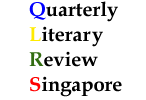 |
 |
|||||||||||||
|
A Freudian fable for our times
By Christine Chia
Sister Snake Sister Snake wears its values proudly on its sleeve. It is no accident that the trans student protest against the unbending rules of the Singapore Ministry of Education virtually opens and ends the book, to remind the reader that being true to oneself always comes at a cost, anywhere and anytime, but especially in modern-day Singapore. However, to repress oneself to conform to society's superego is ultimately futile, as one's real nature inevitably returns with compounded ferocity the longer it has been denied. In this breathtakingly brisk romp from AD 815 Hangzhou to 2020s Singapore, with the briefest of pitstops in Prohibition-era Harlem, Victorian England, and Delhi during the Sepoy Mutiny, Emerald, aka Xiaoqing, our protagonist, is the embodiment of the Freudian id. She seduces men and women with her irresistible joie de vivre. She barely tries to hide her identity of immortal snake spirit:
Bai Suzhen, her snake sworn sister, is her polar opposite, a Stepford wife and superego figure riddled with self-loathing species dysphoria so severe that she adopts a vegan diet and masochistically refuses to moult:
Surprisingly, with all the superhuman beauty and power the sister snakes have, the most compelling character in the novel is Tik, Su's bodyguard, who is assigned female at birth but lives, breathes and acts as a strong and stoic male action hero. Lee Koe has a canny grasp of Tik's personhood:
And the dilemmas she faces as she navigates how to live undercover in a strict heteronormative society:
Lee Koe intentionally made Tik, a mere mortal, the heart and soul of this novel. It is a wise choice, as it clarifies and humanises the criticism of Singaporean governance that weaves through the book, and notably at its climax:
Rather than being a deviant, Tik is the bravest and purest of all the characters in the novel, and her characterisation is convincing, not cloying. On the subject of convincing characters, Su's husband, Paul, and his rival, Riz, are caricatures of Singaporean Chief Minister aspirants, and their flatness is a feature, not a bug. They are there for us to see that success, in the Singaporean system, comes at the cost of the soul:
Several reviewers have already mentioned that some facts of Singaporean life and society that we take for granted as native readers are overexplained in the novel as it is also published in overseas Anglophone markets, particularly North America. Mostly, this expositional material is noticeable but not obtrusive, until Lee Koe slows down the narrative to explain why Tik is still staying with their mother, at a nail-biting turning point in the plot:
Sister Snake, for all its merits, is not for everyone. It is not for fans of the establishment, or the faint-hearted, as the graphic deaths pile up from the start. It is, also, not for readers who like their fictional worlds and characters to be minutely observed as the pace is cracking from the get-go. Like Amanda Lee Koe herself, whose green book tour outfits and neon green streaks in her hair (author's photo) blazon that she is an Emerald, you either love it, and want to tell everyone about it, or you want to ban it. QLRS Vol. 24 No. 3 Jul 2025_____
|
|
|||||||||||||
Copyright © 2001-2025 The Authors
Privacy Policy | Terms of Use |
E-mail